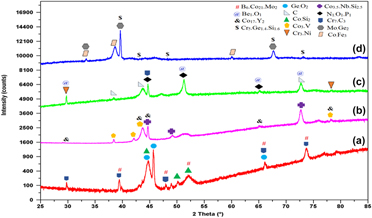Crossref Citations
This article has been cited by the following publications. This list is generated based on data provided by
Crossref.
Devgan, Sandeep
and
Sidhu, Sarabjeet Singh
2019.
Evolution of surface modification trends in bone related biomaterials: A review.
Materials Chemistry and Physics,
Vol. 233,
Issue. ,
p.
68.
Mahajan, Amit
and
Sidhu, Sarabjeet Singh
2019.
Potential of electrical discharge treatment to enhance the in vitro cytocompatibility and tribological performance of Co–Cr implant.
Journal of Materials Research,
Vol. 34,
Issue. 16,
p.
2837.
Singh, Gurpreet
Sidhu, Sarabjeet Singh
Bains, Preetkanwal Singh
Singh, Malkeet
and
Bhui, Amandeep Singh
2020.
On surface Modification of Ti Alloy by Electro Discharge Coating Using Hydroxyapatite Powder Mixed Dielectric with Graphite Tool.
Journal of Bio- and Tribo-Corrosion,
Vol. 6,
Issue. 3,
Mahajan, Amit
Sidhu, Sarabjeet Singh
and
Devgan, Sandeep
2020.
Examination of hemocompatibility and corrosion resistance of electrical discharge-treated duplex stainless steel (DSS-2205) for biomedical applications.
Applied Physics A,
Vol. 126,
Issue. 9,
Al-Amin, Md
Abdul-Rani, Ahmad Majdi
Danish, Mohd
Thompson, Harvey M.
Abdu Aliyu, Abdul Azeez
Hastuty, Sri
Zohura, Fatema Tuj
Bryant, Michael G.
Rubaiee, Saeed
and
Rao, T.V.V.L.N.
2020.
Assessment of PM-EDM cycle factors influence on machining responses and surface properties of biomaterials: A comprehensive review.
Precision Engineering,
Vol. 66,
Issue. ,
p.
531.
Wei, Liangyu
Li, Jingyuan
Zhang, Yuan
and
Lai, Huiying
2020.
Effects of Zn content on microstructure, mechanical and degradation behaviors of Mg-xZn-0.2Ca-0.1Mn alloys.
Materials Chemistry and Physics,
Vol. 241,
Issue. ,
p.
122441.
Mahajan, Amit
Singh, Gurpreet
Devgan, Sandeep
and
Sidhu, Sarabjeet Singh
2021.
EDM performance characteristics and electrochemical corrosion analysis of Co-Cr alloy and duplex stainless steel: A comparative study.
Proceedings of the Institution of Mechanical Engineers, Part E: Journal of Process Mechanical Engineering,
Vol. 235,
Issue. 4,
p.
812.
Liu, Ziqian
Liu, Xiaoling
and
Ramakrishna, Seeram
2021.
Surface engineering of biomaterials in orthopedic and dental implants: Strategies to improve osteointegration, bacteriostatic and bactericidal activities.
Biotechnology Journal,
Vol. 16,
Issue. 7,
Chakmakchi, Makdad
Ntasi, Argiro
Mueller, Wolf Dieter
and
Zinelis, Spiros
2021.
Effect of Cu and Ti electrodes on surface and electrochemical properties of Electro Discharge Machined (EDMed) structures made of Co-Cr and Ti dental alloys.
Dental Materials,
Vol. 37,
Issue. 4,
p.
588.
Mahajan, Amit
Devgan, Sandeep
and
Sidhu, Sarabjeet Singh
2021.
Surface alteration of biomedical alloys by electrical discharge treatment for enhancing the electrochemical corrosion, tribological and biological performances.
Surface and Coatings Technology,
Vol. 405,
Issue. ,
p.
126583.
Singh, Gurpreet
Singh, Malkeet
Singh Sidhu, Sarabjeet
and
Ablyaz, Timur Rizovich
2022.
Improving surface characteristics and corrosion resistance of medical grade 316L by titanium powder mixed electro-discharge treatment.
Surface Topography: Metrology and Properties,
Vol. 10,
Issue. 2,
p.
025002.
Davis, Rahul
Singh, Abhishek
Jackson, Mark James
Coelho, Reginaldo Teixeira
Prakash, Divya
Charalambous, Charalambos Panayiotou
Ahmed, Waqar
da Silva, Leonardo Rosa Ribeiro
and
Lawrence, Abner Ankit
2022.
A comprehensive review on metallic implant biomaterials and their subtractive manufacturing.
The International Journal of Advanced Manufacturing Technology,
Vol. 120,
Issue. 3-4,
p.
1473.
Wang, Xi
Liu, Wentao
Yu, Xinding
Wang, Biyao
Xu, Yan
Yan, Xu
and
Zhang, Xinwen
2022.
Advances in surface modification of tantalum and porous tantalum for rapid osseointegration: A thematic review.
Frontiers in Bioengineering and Biotechnology,
Vol. 10,
Issue. ,
ÇAVDAR, Faruk
YILDIZ, Can
and
KANCA, Erdoğan
2023.
Response Surface Modeling of Material Removal and Tool Wear Rate in Powder Mixed Electrical Discharge Machining of CoCrMo Alloy.
Journal of Materials and Mechatronics: A,
Vol. 4,
Issue. 2,
p.
571.
Kumaran, V
and
Muralidharan, B
2023.
Electric discharge coating process: a critical review with potential application.
Engineering Research Express,
Vol. 5,
Issue. 1,
p.
012005.
YILDIZ, Can
ÇAVDAR, Faruk
and
KANCA, Erdoğan
2023.
A Response Surface Modeling Study on Effects of Powder Rate and Machining Parameters on Surface Quality of CoCrMo Processed by Powder Mixed Electrical Discharge Machining.
Karadeniz Fen Bilimleri Dergisi,
Vol. 13,
Issue. 2,
p.
415.
Mahto, Vinod Kumar
Singh, Arvind Kumar
and
Malik, Anup
2023.
Surface modification techniques of magnesium-based alloys for implant applications.
Journal of Coatings Technology and Research,
Vol. 20,
Issue. 2,
p.
433.
Korgal, Akash
Shettigar, Arun Kumar
Karanth P, Navin
and
Prabhakar, D. A. P.
2024.
Advances in micro electro discharge machining of biomaterials: a review on processes, industrial applications, and current challenges.
Machining Science and Technology,
Vol. 28,
Issue. 2,
p.
215.
Kumar, Alok
and
Singh, Abhishek
2024.
Surface Modification of Magnesium Alloy AZ91D Using Nanopowder Mixed Electrical Discharge Machining for Biodegradable Implant
.
Journal of Long-Term Effects of Medical Implants,
Vol. 34,
Issue. 4,
p.
83.
Munyensanga, Patrick
Bricha, Meriame
and
El Mabrouk, Khalil
2024.
Functional characterization of biomechanical loading and biocorrosion resistance properties of novel additively manufactured porous CoCrMo implant: Comparative analysis with gyroid and rhombic dodecahedron.
Materials Chemistry and Physics,
Vol. 316,
Issue. ,
p.
129139.



